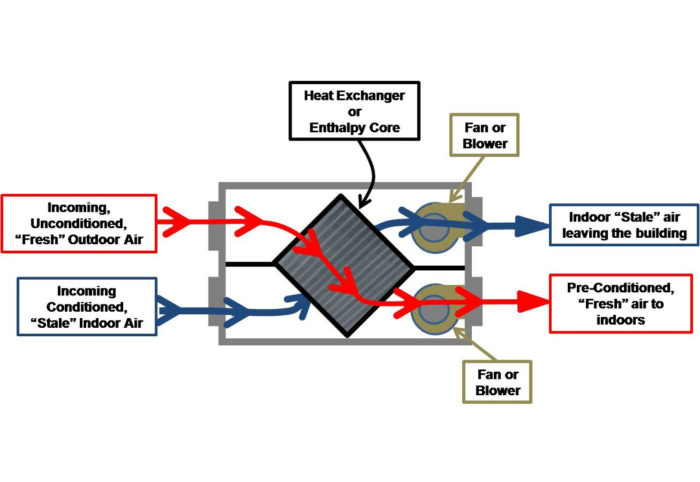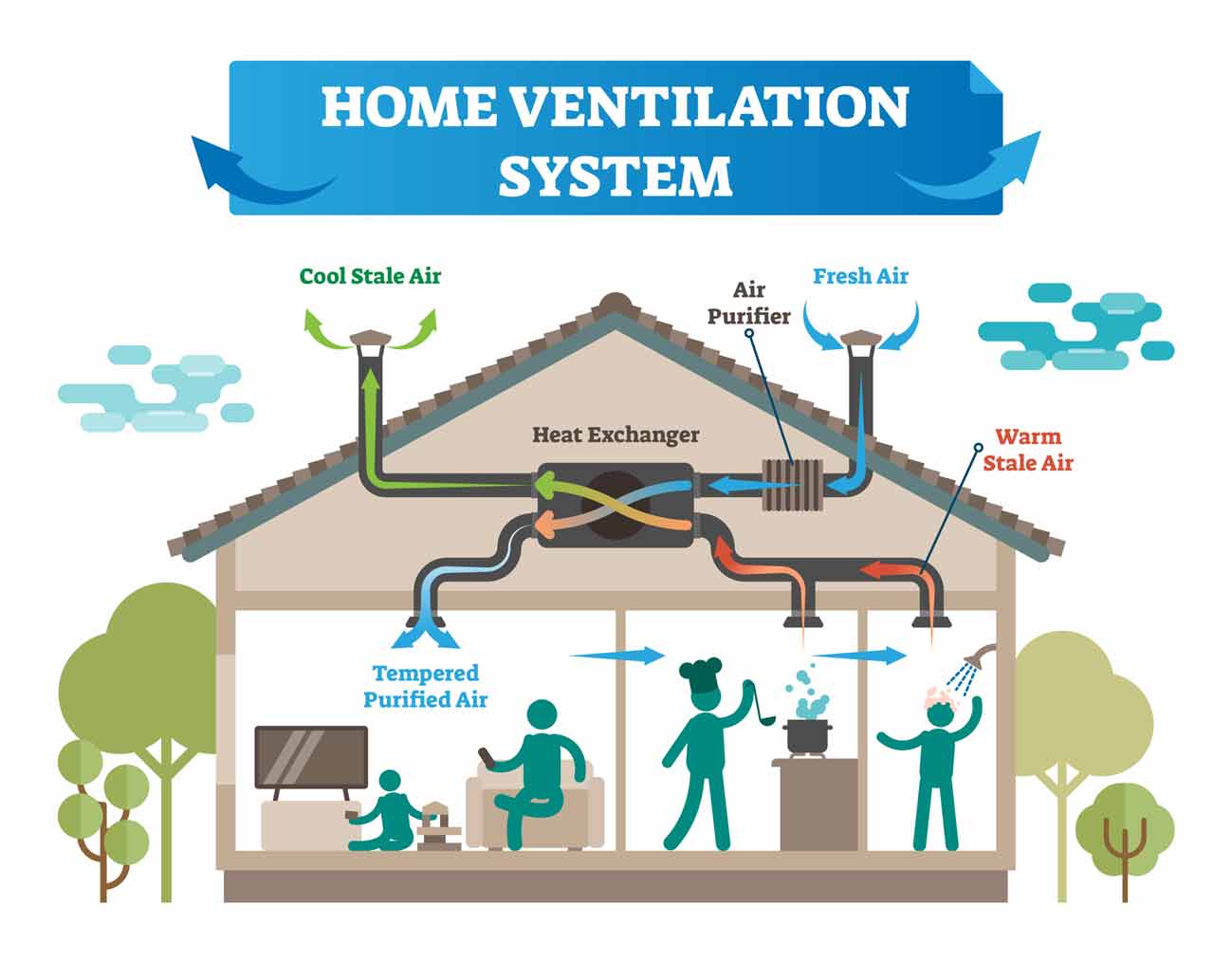Revealing the Secret Benefits and Uses of Heat Recovery Ventilation in Lasting Style
Heat Recovery Ventilation (HRV) systems play an essential duty in sustainable layout. They help with a continual exchange of stale interior air with fresh outdoor air, significantly improving interior air top quality. Additionally, HRVs add to energy effectiveness by redeeming warm from worn down air, which can lower energy prices. Understanding the complex benefits and applications of HRVs exposes their value in contemporary style. What other advantages do these systems supply in the search of sustainability?
Recognizing Heat Recovery Ventilation Equipments
Heat recovery ventilation (HRV) systems are designed to boost indoor air top quality while lessening energy loss. These systems utilize a mechanical ventilation strategy to exchange stale interior air with fresh exterior air, making sure a continual supply of clean air. By recording heat from the exhaust air, HRVs prerequisite inbound air, reducing the demand on home heating and cooling down systems. This process not just boosts thermal convenience yet also adds to power efficiency in property and business buildings. Additionally, HRV systems assist manage moisture degrees and reduce indoor toxins, advertising a much healthier living environment. Their strategic execution is necessary for attaining sustainable layout goals, as they provide a balance between power conservation and owner wellness.
How HRV Solution Work
While numerous may know with air flow systems, comprehending exactly how warm healing ventilation (HRV) systems operate is vital for valuing their benefits. HRV systems work by exchanging stale interior air with fresh outside air while transferring warm between the 2 streams. This process takes place in a warmth exchanger, where warm from the outgoing air heats the inbound air during cooler months, lessening energy loss. Conversely, in warmer months, the system can cool down incoming air using the cooler outbound air. HRVs are furnished with followers to assist in air movement and filters to get rid of particulates, making certain a constant, balanced ventilation procedure. This ingenious layout not only improves energy performance but also adds to keeping a comfy interior environment.
Enhancing Indoor Air High Quality
Indoor air high quality can greatly impact wellness and wellness, making effective air flow important in contemporary homes. Heat Recovery Ventilation (HRV) systems play a necessary role in maintaining indoor air quality by continually exchanging stagnant interior air with fresh outdoor air. This procedure not only decreases airborne toxins but likewise minimizes moisture degrees, which can cause mold and mildew growth and respiratory issues. HRV systems filter incoming air, eliminating allergens and particulates, thereby supplying a healthier living environment. Additionally, these systems assist get rid of odors and unstable organic compounds (VOCs) frequently located in house items. By making sure a consistent flow of tidy air, HRV systems contribute to a general better interior environment, promoting convenience and wellness for owners.
Power Effectiveness and Expense Savings
Energy effectiveness stands out as a substantial advantage of Heat Recovery Ventilation (HRV) systems. By catching and reusing the warm from tired indoor air, HRVs reduce the energy needed for home heating inbound fresh air, bring about lowered power intake. This efficiency equates right into reduced energy bills, supplying considerable cost savings for property owners and services alike. In addition, HRV systems typically receive energy effectiveness rewards and discounts, additionally boosting their economic allure. In time, the preliminary investment in HRV technology can cause a beneficial return on financial investment via reduced energy costs. The integration of HRV systems not only advertises lasting design yet also supplies a functional remedy for achieving long-lasting power savings and monetary advantages.
Ecological Advantages of HRV

A wide range of ecological advantages occurs from the application of Heat Recovery Ventilation (HRV) systems. By efficiently transferring heat from exhaust air to inbound fresh air, HRVs significantly lower the energy needed for heating and cooling down rooms. This energy performance translates to decrease greenhouse gas discharges, contributing to a decrease in the total carbon footprint of structures. Furthermore, HRV systems improve indoor air top quality by constantly flowing fresh air, therefore lowering the focus of indoor contaminants and irritants. The decrease in energy intake aids in saving natural resources, making HRVs a vital component of lasting style. Overall, the ecological advantages of HRVs play a crucial function in advertising a healthier world and fostering environmentally friendly structure methods.
Versatile Applications in Modern Design
Heat recovery ventilation (HRV) systems are progressively being integrated into both domestic and commercial architectural jobs. In domestic setups, HRVs improve indoor air top quality while maximizing energy effectiveness. In industrial rooms, these systems optimize ventilation techniques, showing their convenience in contemporary building applications.
Residential Projects Combination
While modern-day style increasingly stresses sustainability, the assimilation of warmth healing air flow systems in household tasks has arised as a sensible service for boosting indoor air high quality and power efficiency. These systems efficiently move warmth from exhaust air to inbound fresh air, minimizing power loss and reducing home heating or cooling down demands. In new builds and retrofits alike, warm recovery air flow can be seamlessly integrated, providing house owners with a healthier living environment while lowering utility expenses. Furthermore, with raising understanding of environmental influences, more engineers and contractors are identifying the long-term benefits of these systems. Therefore, heat recovery ventilation has ended up being a critical element of sustainable residential design, showcasing adaptability and commitment to green practices.
Business Spaces Optimization
As modern business areas progress to fulfill the needs of sustainability and efficiency, the application of warmth healing air flow systems arises as a key strategy for maximizing interior settings. These systems promote the exchange of stale interior air with fresh outside air while reclaiming heat energy, substantially minimizing energy usage. This not just boosts comfort for owners however additionally aids in reducing operational prices. Flexible applications can be observed in offices, retail spaces, and schools, where air quality and temperature control are extremely important. In addition, incorporating heat recovery ventilation aligns with eco-friendly building certifications, even more promoting ecological obligation. Inevitably, embracing such systems in industrial style not just contributes to sustainability objectives however likewise promotes much healthier, much more productive areas for individuals.
Incorporating HRV Into Sustainable Style Practices
Incorporating warm healing ventilation (HRV) systems into sustainable style techniques supplies substantial benefits in energy effectiveness and interior air high quality. By making use of HRV, designers can produce cost-effective solutions that not just minimize power usage yet likewise boost the total comfort of interior environments. This positioning with sustainability objectives placements HRV as an essential element in contemporary building approaches.
Energy Efficiency Improvement
By including warm recuperation ventilation (HRV) systems right into sustainable layout techniques, designers and building contractors can considerably enhance power efficiency in modern-day building and constructions. HRV systems operate by catching heat from outward bound stagnant air and transferring it to inbound fresh air, minimizing the power required for home heating or cooling indoor areas. This procedure not just lowers reliance on conventional a/c systems however also decreases total power consumption. Additionally, HRV systems can assist keep a regular interior temperature, reducing peak energy needs. By incorporating these systems, buildings can achieve considerable reductions in utility costs and carbon footprints, aligning with sustainability goals. Inevitably, HRV modern technology stands for a practical option for improving energy effectiveness in the constructed environment, promoting even more accountable source usage.
Indoor Air Quality Enhancement
Exactly how can heat healing air flow (HRV) systems add to remarkable interior air high quality in modern-day structures? HRV systems efficiently exchange stagnant indoor air i was reading this with fresh exterior air while recuperating heat power, decreasing temperature variations. This process decreases the focus of interior contaminants, the original source such as volatile natural compounds (VOCs), allergens, and moisture, which can wear away air high quality and effect resident wellness. By keeping ideal humidity degrees and guaranteeing a constant supply of tidy air, HRVs assist develop a much healthier interior setting. Additionally, these systems can be incorporated into sustainable layout methods, advertising energy effectiveness together with boosted air quality. HRV Heat Recovery Ventilation. Consequently, HRV technology plays an essential function in progressing general resident comfort and health in contemporary architectural layouts
Affordable Style Solutions

Frequently Asked Inquiries
What Maintenance Is Needed for Heat Recovery Ventilation Systems?

Upkeep for heat recuperation air flow systems typically includes routine filter substitutes, cleansing of warmth exchangers, examination of fans and air ducts, and making sure correct drain. These jobs assist preserve efficiency and prolong the system's lifespan over time.
Can HRV Solutions Be Mounted in Existing Buildings?
Heat recovery ventilation systems can indeed be set up in existing buildings. HRV Heat Recovery Ventilation. Retrofitting needs cautious preparation and assessment of the structure's layout, guaranteeing compatibility with existing systems while taking full advantage of power effectiveness and interior air high quality
How Do HRV Systems Influence Sound Levels Inside?
HRV systems can influence indoor noise levels by introducing sound from external resources via air flow. Nevertheless, top quality installments typically include sound-dampening functions, reducing noise influence while giving efficient air exchange and preserving convenience indoors.
Exist Any Kind Of Drawbacks to Utilizing HRV Solutions?
The drawbacks of using HRV systems consist of prospective high initial expenses, upkeep challenges, and the opportunity of minimized indoor air quality if filters are not on a regular basis altered, which could result in problems with moisture levels.
Just how Do I Select the Right HRV System for My Demands?
Picking the appropriate warm recovery air flow system entails examining particular requirements, such as building dimension, environment, and power effectiveness goals. In addition, my site examining system functions, installation needs, and maintenance factors to consider is crucial for peak performance and complete satisfaction.